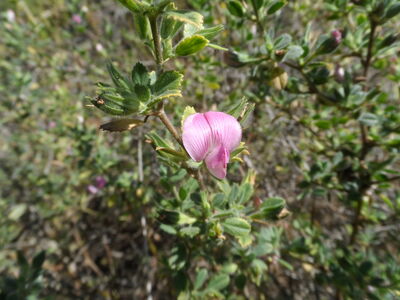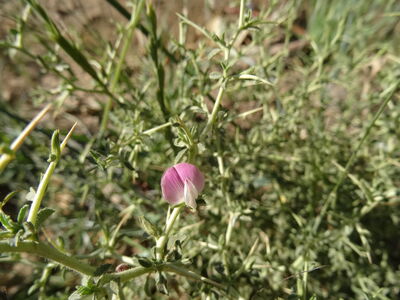Trifolieae forms a morphologically distinctive tribe, although the position of both Ononis and Parochetus has been questioned (see below). In total there are 6 genera and c. 485 species, of which more than half belong to Trifolium (Fig. 56). The distribution of the tribe is centred in the N temperate regions of the Old World, particularly in areas of winter rainfall. Trifolium itself has spread into the tropics on mountains, where there has been considerable diversification, particularly in Ethiopia. It is also the only genus of the tribe to occur naturally in the New World. Parochetus occurs only on palaeotropical mountains. The importance of some genera as fodder legumes, particularly Trifolium and Medicago, has led to their introduction to many parts of the world.
Ononis was placed in a tribe of its own, Ononideae, by Hutchinson (1964) and this has been followed by some (e.g., Yakovlev et al., 1996). The distinctness of Parochetus (and of Ononis) was emphasised by Small & Jomphe (1989), and Chaudhary & Sanjappa (1998a) have placed Parochetus in its own subtribe Parochetinae.
Within the core of Trifolieae, there are some problems in generic delimitation, particularly between Trigonella, Medicago and Melilotus, with some (e.g., Yakovlev et al., 1996) recognising the intermediate genus Melilotoides. Distinctive species here placed in Medicago have been variously segregated as Radiata (Pseudomelissitus), Rhodusia, Crimea, Kamiella and Factorovskya. This treatment follows Small (1987) and Small et al. (1987) in recognising an expanded Medicago including all those species with explosively tripping flowers. In Trifolium, on the other hand, the generic boundaries are reasonably clear, but the unit can be treated either as a large genus with several well-defined sections (the course followed here), or as the separate genera Amoria, Chrysaspis, Lupinaster and Trifolium sens. strict. (see below).
Trifolieae forms part of the ‘temperate epulvinate series’ of Polhill (1981a). In the same volume Heyn (1981) was unable to suggest a clear relationship to any other tribe. The morphological cladistic analysis of the whole family by Chappill (1995) placed Trifolieae next to Cicer. Kupicha (1977) had earlier suggested that Cicer is closest to Trifolieae, with the adnation of the stipules to the petiole in Trifolieae being the only differential character; the tribes Cicereae and Trifolieae also share the characters of long-stalked glandular hairs and serrate leaflets with craspedodromous venation. Doyle (1995) placed Trifolieae, along with Carmichaelieae, Cicereae, Galegeae, Hedysareae, Fabeae and some Millettieae in a group characterised by the loss of the inverted repeat (IR) (Liston, 1995). Endo & Ohashi (1997) placed Trifolieae as sister to the Cicereae and Fabeae (as Vicieae) in a cladistic analysis based on a range of non-molecular characters. Wojciechowski et al. (2000) distinguish a Vicioid clade that includes Trifolieae, Cicereae and Fabeae (as Vicieae), as well as Galega. Within this clade, Parochetus is basally branching to the rest of the taxa, and Galega plus Cicereae form a sister group to a paraphyletic Trifolieae, with Fabeae emerging as sister to Trifolium. In a clade sister to Trifolium and Fabeae, Wojciechowski et al. (2000) and Steele & Wojciechowski (2003) place Ononis basally branching to the sister monophyletic clades Medicago, and Melilotus-Trigonella (Fig. 56). The latter three genera comprise tribe Trigonelleae of Schulz (1901).
Given that molecular phylogenies do not support a monophyletic Trifolieae in its current form, further study may reinforce the pattern of relationships suggested so far by these analyses. A tribe Trigonelleae could be recognised including the genus Ononis, and tribe Trifolieae would then only include the genus Trifolium, sister to tribe Fabeae. The Trifolieae in its broader paraphyletic sense is maintained here pending further study. The ‘supertree’ of Wojciechowski et al. (2001) is not supportive of the segregate genera of Trifolium; more thorough sampling of Trifolium and other large genera is desirable before any final conclusions can be drawn.
Sometimes placed in the separate tribe Ononideae Hutch. because of its monadelphous stamens and dimorphic anthers (by, e.g., Yakovlev et al. (1996) and Devesa in Talavera et al. (2000))






